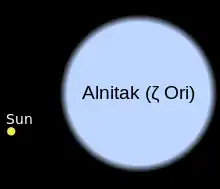| Observation data Epoch J2000 Equinox J2000 | |
|---|---|
| Constellation | Orion |
| Pronunciation | /ælˈnaɪtæk/,[1] |
| Right ascension | 05h 40m 45.52666s[2] |
| Declination | −01° 56′ 34.2649″[2] |
| Apparent magnitude (V) | 1.77[3] (2.08 + 4.28 + 4.01[4]) |
| Characteristics | |
| Spectral type | O9.5Iab + B1IV + B0III[4] |
| U−B color index | −1.06[3] |
| B−V color index | −0.11 (A) −0.20 (B)[5] |
| Astrometry | |
| Radial velocity (Rv) | 18.50[6] km/s |
| Proper motion (μ) | RA: 3.19[2] mas/yr Dec.: 2.03[2] mas/yr |
| Parallax (π) | 4.43 ± 0.64 mas[2] |
| Distance | 1,260 ± 180 ly (387 ± 54[4] pc) |
| Absolute magnitude (MV) | −6.0 / −3.9 / −4.1[4] |
| Orbit[4] | |
| Primary | Aa |
| Companion | Ab |
| Period (P) | 2,687.3±7.0 d |
| Semi-major axis (a) | 35.9±0.2 mas |
| Eccentricity (e) | 0.338±0.004 |
| Inclination (i) | 139.3±0.6° |
| Longitude of the node (Ω) | 83.8±0.8° |
| Periastron epoch (T) | JD 2452734.2±9.0 |
| Argument of periastron (ω) (secondary) | 204.2±1.2° |
| Semi-amplitude (K1) (primary) | 10.1 km/s |
| Semi-amplitude (K2) (secondary) | 19.6 km/s |
| Orbit[7] | |
| Primary | A |
| Companion | B |
| Period (P) | 1,508.6 yr |
| Semi-major axis (a) | 2.728″ |
| Eccentricity (e) | 0.07 |
| Inclination (i) | 72.0° |
| Longitude of the node (Ω) | 155.5° |
| Periastron epoch (T) | 2,070.6 |
| Argument of periastron (ω) (secondary) | 47.3° |
| Details | |
| Alnitak Aa | |
| Mass | 33±10[4] M☉ |
| Radius | 20.0±3.2[4] R☉ |
| Luminosity | 250,000[4] L☉ |
| Surface gravity (log g) | 3.2±0.1[8] cgs |
| Temperature | 29,500±1,000[4] K |
| Rotation | 6.67 days[9] |
| Rotational velocity (v sin i) | 110±10[4] km/s |
| Age | 6.4[4] Myr |
| Alnitak Ab | |
| Mass | 14±3[4] M☉ |
| Radius | 7.3±1.0[4] R☉ |
| Luminosity | 32,000[4] L☉ |
| Temperature | 29,000[10] K |
| Age | 7.2[4] Myr |
| Alnitak B | |
| Rotational velocity (v sin i) | 350[4] km/s |
| Age | ~7[4] Myr |
| Other designations | |
| A: HD 37742, HR 1948 | |
| B: HD 37743, HR 1949 | |
| Database references | |
| SIMBAD | AB |
| A | |
| B | |
Alnitak is a triple star system in the constellation of Orion. It has the designations ζ Orionis, which is Latinised to Zeta Orionis and abbreviated Zeta Ori or ζ Ori, and 50 Orionis, abbreviated 50 Ori. The system is located at a distance of several hundred parsecs from the Sun and is one of the three main stars of Orion's Belt along with Alnilam and Mintaka.
The primary star, Alnitak Aa, is a hot blue supergiant with an absolute magnitude of −6.0 and is the brightest class O star in the night sky with a visual magnitude of +2.0. It has two companions—Ab and B, the latter known for the longest time and the former discovered recently, producing a combined magnitude for the trio of +1.77. The stars are members of the Orion OB1 association and the Collinder 70 association.
Observational history

Alnitak has been known since antiquity and, as a component of Orion's Belt, has been of widespread cultural significance. It was reported to be a double star by amateur German astronomer George K. Kunowsky in 1819.[11] Much more recently, in 1998, the bright primary was found by a team from the Lowell Observatory to have a close companion; this had been suspected from observations made with the Narrabri Stellar Intensity Interferometer in the 1970s.[12]
The stellar parallax derived from observations by the Hipparcos satellite imply a distance around 225 parsecs, but this does not take into account distortions caused by the multiple nature of the system and larger distances have been derived by many authors.[4]
Stellar system

Alnitak is a triple star system at the eastern end of Orion's Belt, the second-magnitude primary having a 4th-magnitude companion nearly 3 arcseconds distant, in an orbit taking over 1,500 years.
The part called Alnitak A is itself a close binary, comprising the stars Alnitak Aa and Alnitak Ab.
Alnitak Aa is a blue supergiant of spectral type O9.5Iab with an absolute magnitude of −6.0 and an apparent magnitude of 2.0. It is estimated as being up to 33 times as massive as the Sun and a diameter 20 times greater. It is some 21,000 times brighter than the Sun, with a surface brightness (luminance) some 500 times greater. It is the brightest star of class O in the night sky.
Alnitak Ab is a blue subgiant of spectral type B1IV with an absolute magnitude of −3.9 and an apparent magnitude of 4.3, discovered in 1998.[12]
A fourth star, 9th-magnitude Alnitak C, has not been confirmed to be part of the Aa–Ab–B group, and may simply lie along the line of sight.
The Alnitak system is bathed in the nebulosity of IC 434.
Etymology and cultural significance
ζ Orionis (Latinised as Zeta Orionis) is the star system's Bayer designation and 50 Orionis its Flamsteed designation.
The traditional name Alnitak, alternately spelled Al Nitak or Alnitah, is taken from the Arabic النطاق an-niṭāq, "the girdle".[11] In 2016, the International Astronomical Union organized a Working Group on Star Names (WGSN)[13] to catalog and standardize proper names for stars. The WGSN's first bulletin of July 2016[14] included a table of the first two batches of names approved by the WGSN; which included Alnitak for the star ζ Orionis Aa. It is now so entered in the IAU Catalog of Star Names.[15]
Orion's Belt
The three belt stars were collectively known by many names in many cultures. Arabic terms include النجاد Al Nijād 'the Belt', النسك Al Nasak 'the Line', العلقات Al Alkāt 'the Golden Grains or Nuts' and, in modern Arabic, ميزان الحق Al Mīzān al Ḥaqq 'the Scale of Justice'. In Chinese mythology they were known as The Weighing Beam.[11]
The belt was also the Three Stars mansion (simplified Chinese: 参宿; traditional Chinese: 參宿; pinyin: Shēn Xiù), one of the twenty-eight mansions of the Chinese constellations. It is one of the western mansions of the White Tiger.
In Chinese, 參宿 (Shēn Xiù), meaning Three Stars (asterism), refers to an asterism consisting of Alnitak, Alnilam and Mintaka (Orion's Belt), with Betelgeuse, Bellatrix, Saiph and Rigel later added.[16] Consequently, the Chinese name for Alnitak is 參宿一 (Shēn Xiù yī, English: the First Star of Three Stars).[17] It is one of the western mansions of the White Tiger.
Namesakes
The USS Alnitah was a U.S. Navy Crater-class cargo ship named after the star.
See also
References
- ↑ Kunitzsch, Paul; Smart, Tim (2006). A Dictionary of Modern star Names: A Short Guide to 254 Star Names and Their Derivations (2nd rev. ed.). Cambridge, Massachusetts: Sky Pub. ISBN 978-1-931559-44-7.
- 1 2 3 4 5 Van Leeuwen, F. (2007). "Validation of the new Hipparcos reduction". Astronomy and Astrophysics. 474 (2): 653–664. arXiv:0708.1752. Bibcode:2007A&A...474..653V. doi:10.1051/0004-6361:20078357. S2CID 18759600.
- 1 2 Ducati, J. R. (2002). "VizieR Online Data Catalog: Catalogue of Stellar Photometry in Johnson's 11-color system". CDS/ADC Collection of Electronic Catalogues. 2237: 0. Bibcode:2002yCat.2237....0D.
- 1 2 3 4 5 6 7 8 9 10 11 12 13 14 15 16 17 18 Hummel, C. A.; Rivinius, T.; Nieva, M. -F.; Stahl, O.; Van Belle, G.; Zavala, R. T. (2013). "Dynamical mass of the O-type supergiant in ζ Orionis A". Astronomy & Astrophysics. 554: A52. arXiv:1306.0330. Bibcode:2013A&A...554A..52H. doi:10.1051/0004-6361/201321434. S2CID 53645495.
- ↑ Fabricius, C.; Høg, E.; Makarov, V. V.; Mason, B. D.; Wycoff, G. L.; Urban, S. E. (2002). "The Tycho double star catalogue". Astronomy and Astrophysics. 384 (1): 180–189. Bibcode:2002A&A...384..180F. doi:10.1051/0004-6361:20011822. ISSN 0004-6361.
- ↑ Kharchenko, N.V.; Scholz, R.-D.; Piskunov, A.E.; Röser, S.; Schilbach, E. (2007). "Astrophysical supplements to the ASCC-2.5: Ia. Radial velocities of ~55000 stars and mean radial velocities of 516 Galactic open clusters and associations". Astronomische Nachrichten. 328 (9): 889–896. arXiv:0705.0878. Bibcode:2007AN....328..889K. doi:10.1002/asna.200710776. ISSN 0004-6337. S2CID 119323941.
- ↑ "Sixth Catalog of Orbits of Visual Binary Stars". United States Naval Observatory.
- ↑ Raassen, A. J. J.; Van Der Hucht, K. A.; Miller, N. A.; Cassinelli, J. P. (2008). "XMM-Newton observations of ζ Orionis (O9.7 Ib): A collisional ionization equilibrium model". Astronomy and Astrophysics. 478 (2): 513. arXiv:0803.0873. Bibcode:2008A&A...478..513R. doi:10.1051/0004-6361:20077891. S2CID 17601299.
- ↑ Buysschaert, B.; Neiner, C.; Ramiaramanantsoa, T.; Richardson, N. D.; David-Uraz, A.; Moffat, A. F. J. (2016). "Understanding the photometric variability of ζ OriAa". Second Brite-Constellation Science Conference: Small Satellites – Big Science. 5: 101. arXiv:1610.05625. Bibcode:2017sbcs.conf..101B.
- ↑ Blazère, A.; Neiner, C.; Tkachenko, A.; Bouret, J.-C.; Rivinius, Th. (2015). "The magnetic field of ζ Orionis A". Astronomy & Astrophysics. 582: A110. arXiv:1509.02773. Bibcode:2015A&A...582A.110B. doi:10.1051/0004-6361/201526855. S2CID 62800990.
- 1 2 3 Richard Hinckley Allen, Star-names and their meanings (1936), p. 314–15.
- 1 2 Hummel CA; White NM; Elias NM II; Hajian AR; Nordgren TE (2000). "ζ Orionis A Is a Double Star". The Astrophysical Journal. 540 (2): L91–L93. Bibcode:2000ApJ...540L..91H. doi:10.1086/312882.
- ↑ "IAU Working Group on Star Names (WGSN)". Retrieved 22 May 2016.
- ↑ "Bulletin of the IAU Working Group on Star Names, No. 1" (PDF). Retrieved 28 July 2016.
- ↑ "IAU Catalog of Star Names". Retrieved 28 July 2016.
- ↑ (in Chinese) 中國星座神話, written by 陳久金. Published by 台灣書房出版有限公司, 2005, ISBN 978-986-7332-25-7.
- ↑ (in Chinese) AEEA (Activities of Exhibition and Education in Astronomy) 天文教育資訊網 2006 年 5 月 25 日
External links
- "Alnitak 3". SolStation. Retrieved 2005-12-15.
- NASA Astronomy Picture of the Day: Image of Alnitak (12 January 2010)
- Alnitak on WikiSky: DSS2, SDSS, GALEX, IRAS, Hydrogen α, X-Ray, Astrophoto, Sky Map, Articles and images
